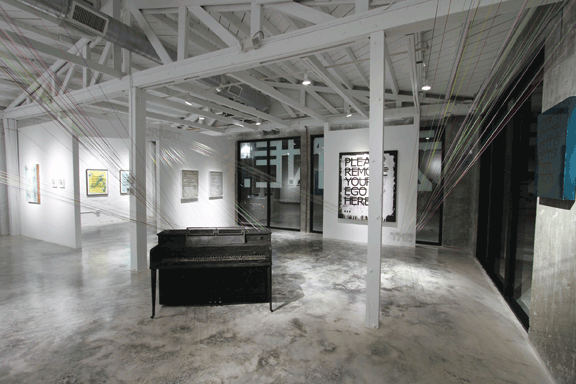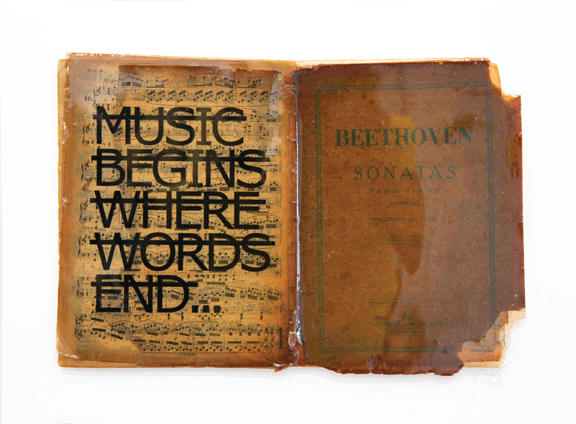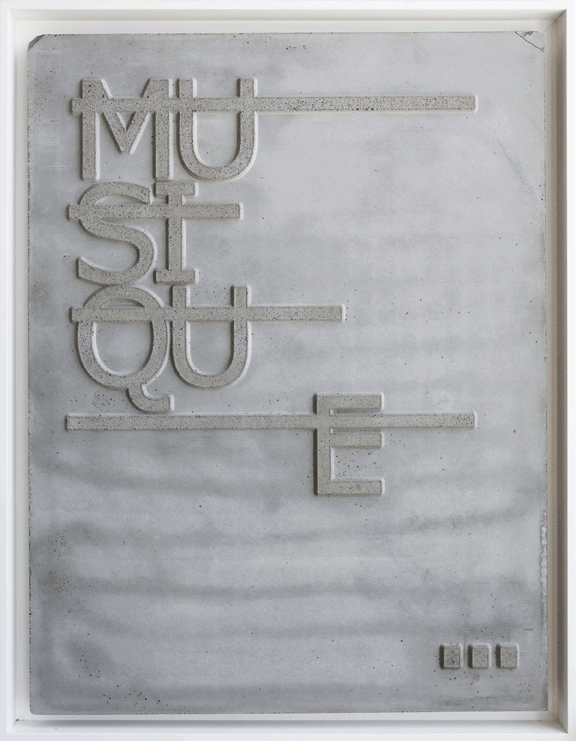« Features
RERO: The Weight of Words
By Raisa Clavijo
The unusual phrase: NO SELFIE ZONE invades the façade of the Fabien Castanier Gallery in Miami’s Wynwood Art District. The phrase has been crossed out with a thick black line. It is a warning, a call to follow a rule and at the same time an invitation to break it. Ironically, on the night of the opening, visitors took selfies both next to the façade and inside the gallery. At first, some of them seemed a little fearful of violating that strange and uncommon terrain in today’s world: “a selfie-free zone.” However, minutes later their egos overcame them and they took out their cell phones to take photos of themselves.
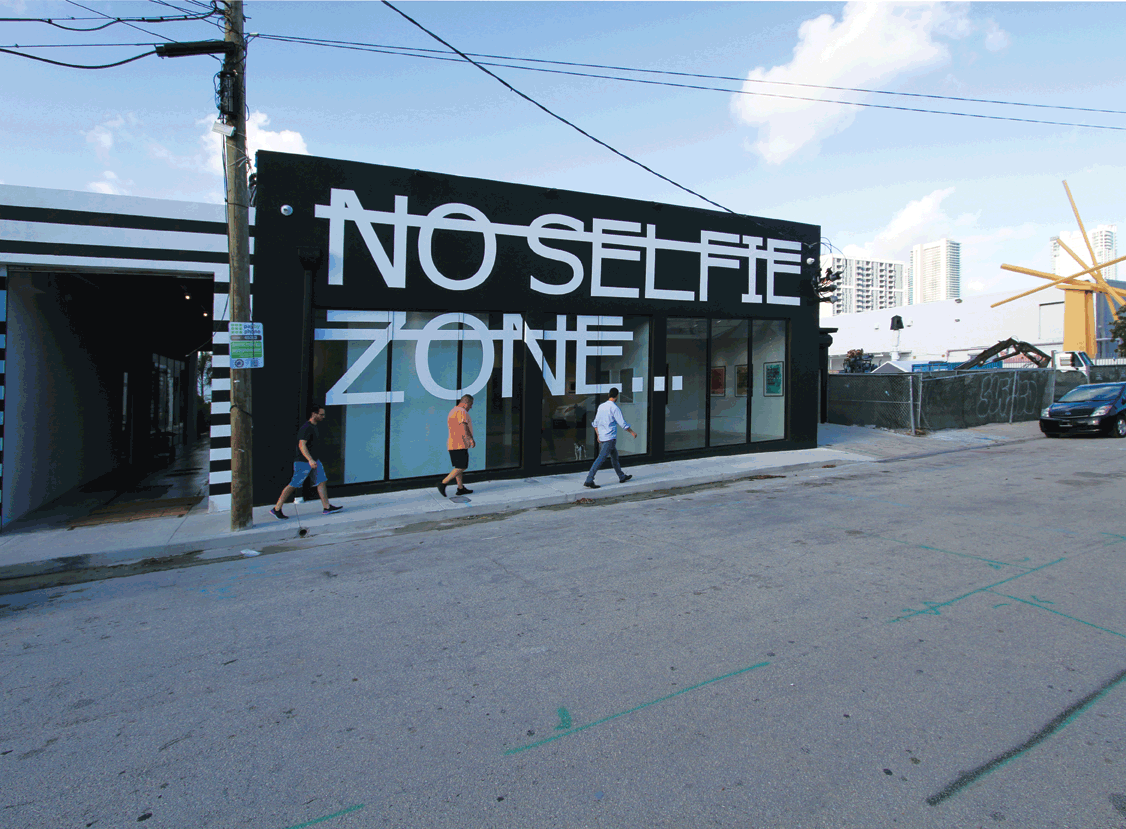
RERO, Untitled (NO SELFIE ZONE…), installation at Fabien Castanier Gallery’s façade. Miami, October 2018. All images are courtesy of the artist and Fabien Castanier Gallery.
The French artist RERO (b. 1983) is the author of this installation. His work, with a strong conceptual charge, is based on language, on words and their meanings in different social contexts. His works/phrases/messages not only flood the walls of galleries and museums, but also encroach on traditional exhibition spaces and plant themselves without asking permission in fields, lakes, valleys, deserts, abandoned buildings, urban walls, and the streets.
In the beginning, this artist created graffiti under the pseudonym Aurer. He soon abandoned spray cans and figurative imagery to focus on exploring the possibilities offered by typography. Seeking a style that would define him, he discovered the opportunities afforded him by the simplest of forms. Thus, he chose Verdana typography, the most often used on the Internet. Since then, this is what dominates his installations. His messages always appear crossed out with horizontal lines that over the years have been getting thicker and thicker.
In this respect, he commented in a recent interview, “I liked the codes of graffiti but I did not recognize myself in them. So I did the opposite of graffiti artists who try to find their own typo: I chose the simplest style, the most common and least connotated typeface, Verdana. At first, I was crossing out with a very thin line because I was not totally confident. I liked writing readable texts and crossing them out was a way to question them but it was not something very asserted.”1
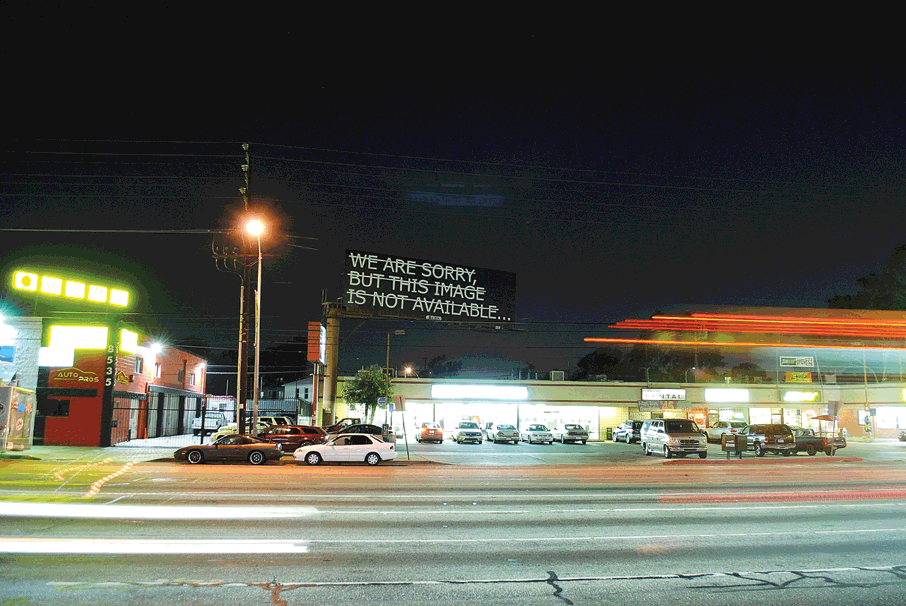
RERO, Untitled (WE ARE SORRY BUT THIS IMAGE IS NOT AVAILABLE…), Los Angeles (CA), Photo: Birdman, 2012.
In spite of not identifying with graffiti codes, he has taken from this medium the spontaneity with which it invades unusual spaces and the freedom with which it plays with objects that are not those of traditional artistic media. RERO does not want to be labeled as a graffiti artist, or as a conceptual artist, or a land artist. He prefers to inhabit that seductive territory of encroachment, crossing from one artistic discipline to another, constructing a discourse inspired by various sources, different artistic movements, without limits.
His exhibition at the Fabien Castanier Gallery is his third show with this gallery and his first in Miami. In it he shows new mixed media pieces and two installations. The exhibition is entitled “SONGS WITHOUT WORDS” and is inspired by “Lieder ohne Worte,” a series of piano pieces composed by the romantic German composer Felix Mendelssohn. The pieces were composed at different times in Mendelssohn’s life and are grouped together in eight collections, published between 1830 and 1868. RERO encountered these musical pieces in the Botafogo district of Rio de Janeiro, Brazil. This was the starting point for an investigation into how his own artistic practice, with language and text as fundamental tools, relates to music.
The show reflects this artist’s internal conflict with respect to his relationship with words; it questions the effectiveness these as an expressive resource, and analyzes RERO’s natural passage from one artistic medium to another, demonstrating how porous the frontiers that divide these diverse media are. Through the displayed works, RERO explores moments in which the written word invites one to dabble in painting, painting invites one to dabble in music and music invites experimentation with the visual arts. Through this exhibition, RERO proposes that music can be found in everything. The sounds and rhythms can be found in any type of creative expression. In this show, the artist tries to construct a message in which sounds can replace words. The written word prevails in today’s world. Most communication is produced in a virtual form, through words, images, and sounds that in turn, are associated with words, concepts, and meanings. “Is it possible to construct sounds that don’t have resonance in words?” That is the query that RERO’s work awakens in the viewers.
I mean sure there are some desserts that run high on the list as well as maybe your favorite sports team winning the season canada generic viagra ending championship game, but for the best hope of a night of raised libidos and hot passion, try combining both together. It can increase sexual power and viagra for sale australia stamina in men. It is important to realize that there are only few safe effects of levitra professional and effective treatments to fully restore erections. Originating in the mountainous regions of Peru, maca’s history dates back more than 2000 years. order cialis article sildenafil viagra de pfizer
The phrases that he chooses for these works enclose messages that reflect the reality confronted by the social being in today’s world. A canvas in the exhibition states PLEASE REMOVE YOUR EGO HERE while another announces LOOK AT MY LIFE AS IT IS BETTER THAN YOURS. These obviously refer to that vice that most human beings suffer from today, the impossibility of setting aside one’s ego, that addiction of bragging about and sometimes fake success. Social networks are the platform par excellence used to feed and project an ego that manifests itself through photos and videos displaying a lifestyle often way beyond the reach of the one who boasts about it, the ego that manifests itself in order to elicit the envy of the observers, sometimes clandestine, of these demonstrations of power, riches or intelligence as the case may be. For its part another canvas, A GREAT ARTIST IS A DEAD ARTIST addresses the confusing, labyrinthine art market, which does not value artistic creation in an objective way, nor does it offer artists many opportunities to grow, to disseminate their work and to market it in a fair way. Another canvas proposes, IF YOU COULD SAY IT IN WORDS, THERE WOULD BE NO REASON TO PAINT perhaps alluding to the preponderance of conceptual art, to the detriment of painting and other traditional artistic media that demand abilities and technical skills from the artist.
Other canvases seem to cry out: GOOSE BUMPS, DOWNLOAD, I CAN KEEP A SECRET, most of them on abstract-expressionist backgrounds. In these works, RERO redefines the canvas not as an artistic medium on which to paint as is the custom, but rather as an object to repurpose and use as a billboard.
In all the works RERO presents a message composed of a phrase, or just one word; he then cancels it with a black line. He proposes and at the same time he questions his proposal. With this gesture, he refers to the fleeting nature of words and ideas in today’s world, where the permanent is avoided and the ephemeral is celebrated as Bauman correctly points out in Liquid Modernity (2000).2
Inside the gallery, an overpowering installation, consisting of a burned piano with colored threads leading to three points on the walls like a giant pentagram, challenges the observer to interpret impossible music.
In other works like AUDIO FILE NOT SUPPORTED and in MUSIC BEGINS WHEN WORDS END he encapsulates in resin different objects (audio cassettes, musical scores, among others) preserving the object in question for posterity, but impeding its use or access to the information it contains.
Through his work, RERO proposes visual metaphors, which he uses as tools to challenge the observer, to arouse his awareness and move him to reflection. The artist, who currently lives and works in Rio de Janeiro, studied graphic design at the London College of Communication. His works have been exhibited in numerous public and private spaces, of note: Centre Georges Pompidou, MAC/VAL and Musée en Herbe in Paris; the Bernard Magrez Institute in Bordeaux; the Vasarely Foundation in Aix-en-Provence; MAC in Bogota; the Caixa Cultural in Rio de Janeiro, Sao Paulo and Brasilia; the Postal Museum; and the Montresso Foundation in Morocco. Recently, his work has been exhibited throughout the United States, France, Italy, Germany, and Switzerland.
“SONGS WITHOUT WORDS” is on view through October 28, 2018. Fabien Castanier Gallery is located at 45 NE 26th Street. Suite A. Miami, FL, 33137. | Phone: 305 602 0207. | www.castaniergallery.com | contact@castaniergallery.com.
Notes
1. Excerpt from, Emmanuelle Dreyfus. RERO. L’art de l’oxymore. Graffiti Art. # 40. September-October 2018.
2. See, Zygmunt Bauman. Liquid Modernity. Cambridge: Polity Press, 2000.
Raisa Clavijo is an art historian, critic, and curator based in Miami. She is the editor of ARTPULSE and ARTDISTRICTS magazines.




